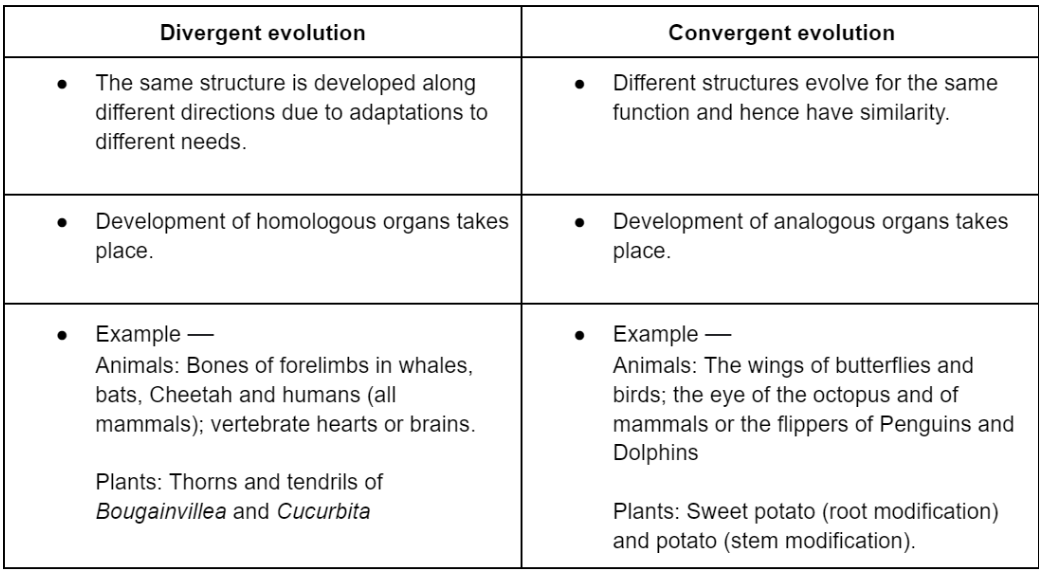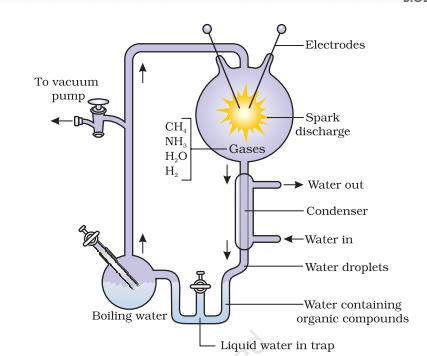CBSE Class 12 Biology Chapter 7 Revision Notes Part 1
Chapter 7: Evolution Revision Notes Part 1
The origin of life is considered a unique event in the history of the universe. The universe is vast. Relatively speaking the earth itself is almost only a speck. The universe is very old – almost 20 billion years old. Huge clusters of galaxies comprise the universe.
The theories of origin of life
1. The Big Bang Theory:
- This theory talks of a singular huge explosion unimaginable in physical terms. The universe expanded and hence, the temperature came down.
- Hydrogen and Helium formed sometime later.
- The gases condensed under gravitation and formed the galaxies of the present day universe.
- In the solar system of the milky way galaxy, earth was supposed to have been formed about 4.5 billion years back.
- There was no atmosphere on early earth.
- Water vapour, methane, carbon dioxide and ammonia released from molten mass covered the surface.
- The UV rays from the sun broke up water into Hydrogen and Oxygen and the lighter H2 escaped.
- Oxygen combined with ammonia and methane to form water, CO2 and others.
- The ozone layer was formed.
- As it cooled, the water vapor fell as rain, to fill all the depressions and form oceans.
- Life appeared 500 million years after the formation of earth, i.e., almost four billion years back.
2. Panspermia Theory:
- Some scientists believe that it came from outside.
- Early Greek thinkers thought units of life called spores were transferred to different planets including earth.
3. Theory of spontaneous generation:
- For a long time it was also believed that life came out of decaying and rotting matter like straw, mud, etc.
4. Louis Pasteur Theory:
- Louis Pasteur by careful experimentation demonstrated that life comes only from pre-existing life.
- He showed that in pre-sterilised flasks, life did not come from killed yeast while in another flask open to air, new living organisms arose from ‘killed yeast’.
5. Oparin and Haldane Theory:
- Oparin of Russia and Haldane of England proposed that the first form of life could have come from pre-existing non-living organic molecules (e.g. RNA, protein, etc.) and that formation of life was preceded by chemical evolution, i.e., formation of diverse organic molecules from inorganic constituents.
6. S.L. Miller Theory:
- The conditions on earth were – high temperature, volcanic storms, reducing atmosphere containing CH4, NH3, etc. In 1953, S.L. Miller, an American scientist, created similar conditions on a laboratory scale.
- He created electric discharge in a closed flask containing CH4, H2, NH3 and water vapour at 800 degree C.
- He observed formation of amino acids. In similar experiments others observed, formation of sugars, nitrogen bases, pigment and fats. Analysis of meteorite content also revealed similar compounds indicating that similar processes are occurring elsewhere in space. With this limited evidence, the first part of the conjectured story, i.e., chemical evolution was more or less accepted.
Evolution of life forms
Theory of special creation: This theory has three connotations –
- That all living organisms (species or types) that we see today were created as such.
- That the diversity was always the same since creation and will be the same in future also.
- That earth is about 4000 years old.
Evidences for evolution:
A study of fossils in different sedimentary layers indicates the geological period in which they existed. Hence, new forms of life have arisen at different times in the history of earth. All this is called paleontological evidence.
1. Embryological support for evolution (Ernst Haeckel’s Biogenetic Law):
This theory was proposed by Ernst Heckel based upon the observation of certain features during the embryonic stage common to all vertebrates that are absent in adulthood.
This theory states that each embryo’s developmental stage represents an adult form of an evolutionary ancestor. Hence, by studying the stages of embryological development one gets to study the history and diversification of life on Earth.
For example, the embryos of all vertebrates including humans develop a row of vestigial gill slits just behind the head but it is a functional organ only in fish and not found in any other adult vertebrates.
However, this proposal was disapproved on careful study performed by Karl Ernst von Baer. He noted that embryos never pass through the adult stages of other animals.
2. Comparative anatomy and morphology shows similarities and differences among organisms of today and those that existed years ago. Such similarities can be interpreted to understand whether commonancestors were shared or not.

3. Evolution by Natural Selection
- In a collection of moths made in 1850s, i.e., before industrialisation set in, it was observed that there were more white-winged moths on trees than dark-winged or melanised moths.
- However, in the collection carried out from the same area, but after industrialisation, i.e., in 1920, there were more dark-winged moths in the same area, i.e., the proportion was reversed.
- The explanation put forth for this observation was that ‘predators will spot a moth against a contrasting background’.
4. Evolution by Anthropogenic Action
- Excess use of herbicides, pesticides, etc., has only resulted in selection of resistant varieties in a much lesser time scale.
- This is also true for microbes against which we employ antibiotics or drugs against eukaryotic organisms/cells.
- Hence, resistant organisms/cells are appearing in a time scale of months or years and not centuries.
Sources:
EVOLUTION. https://ncert.nic.in/textbook/pdf/lebo107.pdf Accessed 20 Dec, 2021.
]]>
